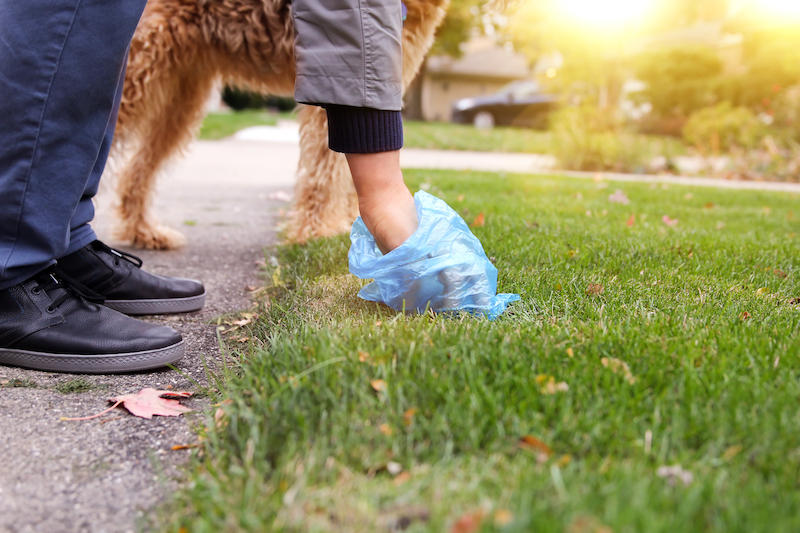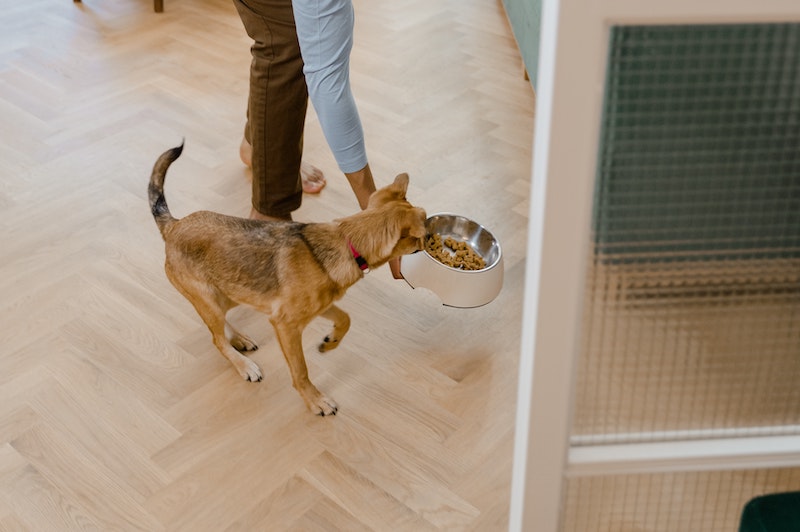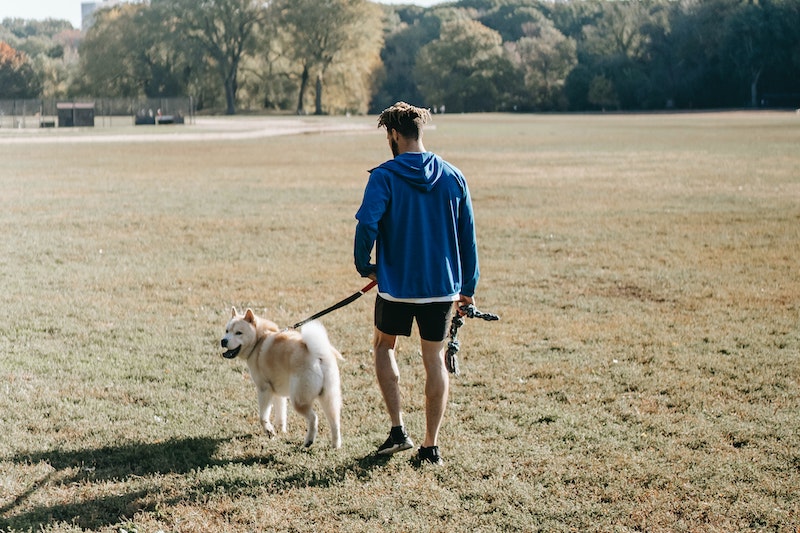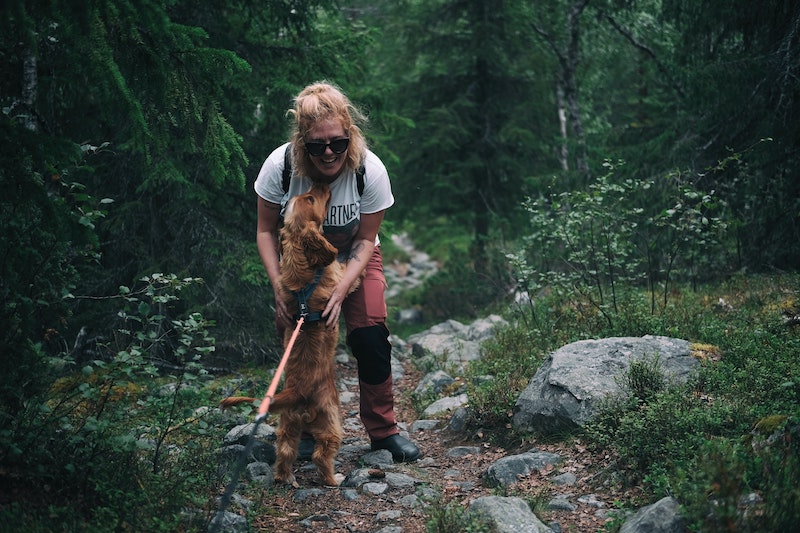The environmental impact of owning a dog is more than you’d think. Depending on their diet, owning a large dog puts about twice as many carbon emissions into the atmosphere as an average family car does each year.
But owning a dog doesn’t mean you can’t be a planet hero too.
Here are 10 tips to help reduce your carbon pawprint as a pet parent. And we get it—real change requires shifts in the pet industry as a whole—and beyond, not just individual actions. But hey, these small habit changes could be a paw-sitive step in the right direction.
1. Spay or neuter your pup

Spaying or neutering your dog doesn’t necessarily impact your carbon footprint directly, but it does contribute to a more sustainable pet population.
Less reproduction means fewer pets, and subsequently, less demand for resources like food, water, and shelter—all of which have environmental (and financial) costs.
If you decide to adopt an older dog from a shelter, they will likely already be spayed or neutered to help prevent unexpected litters. But if you bring home a puppy who isn’t already sterilized, dog insurance can really come in handy to help with the costs of the procedure—which on average run from about $250 to $2,000. For example, when you include the Puppy/Kitten Preventative package on a Lemonade Pet policy, your coverage can help cover things like spaying or neutering, to set them up for life.
2. Pick up after your pet

Picking up your dog’s poop—and properly disposing of it—is so much more than just a common courtesy to your neighbors. There are lots of reasons you should practice responsible pet waste management. It helps to prevent public health issues, and helps to preserve local water sources and public green spaces.
Buying a pooper scooper or biodegradable dog poop bags are a great start. But if you really want to up your eco pet parent game, you can flush your dog’s poop down the toilet, set up a specialized composting system for their waste—or even toilet train your pup.
3. Feed your pooch sustainable dog food

Because of the scale of the pet food industry, each stage of the supply chain—from raw material extraction and farming to manufacturing, distribution, and waste management—can have serious implications for our planet and its natural resources.
Choosing sustainable dog food brands that are transparent about their supply chain and business practices, and have reputable third-party certifications—like MSC, USDA Organic, or Global Animal Partnership—can help minimize negative impacts on the environment.
Just make sure the food also meets your pup’s unique nutritional requirements based on their breed, size, age, and any special dietary needs. Always consult with your vet before switching up your pooch’s food, especially if you’re interested in jumping on a dog diet fad, to make sure they’re getting all the nutrition they need.
4. Opt for walks over drives

Maybe your favorite dog park is a 30-minute drive away, but you live in a walkable area and have access to several good dog parks just a few minutes away on foot.
If possible—and if weather permits—consider taking your dog for a walk around your neighborhood, or to nearby dog parks, rather than driving them to get some exercise. Spending less time behind the wheel means fewer carbon emissions, cleaner air, and less time and money you’re spending at the pump.
Plus, some car insurance companies might reward your low-mileage lifestyle with lower car insurance rates (we’re talking about Lemonade).
5. ‘Leave no trace’ on hikes

When you go hiking with your dog, follow some specific practices to help keep nature pristine and beautiful—like keeping your pooch on a leash, picking up and packing out their waste, and sticking to pet-friendly trails.
This is not only for the sake of local wildlife, but also for other hikers who share the trails with you and your four-legged companion.
6. Train and socialize your dog to respect their surroundings

A well-mannered doggo leads to more sustainable living, and supports ecological balance. Train your pup from an early age to prevent bad behaviors that impact the environment and your community, including:
- Excessive barking
- Chasing wildlife
- Acting aggressively towards other people and animals
- Trampling or digging up plants
- Digging up the ground
- Destroying toys quickly, which could lead to littering, or needing to buy toys more often
7. Shop cruelty-free

Consider brands that are both cruelty-free and vegan when shopping for your own beauty and haircare products, cleaning supplies, clothes, etc. These products are not tested on animals, don’t include animal by-products, and often have a lower environmental impact.
Raising animals for materials or product testing is a resource intensive process (and inhumane in many cases). Also, cruelty-free and vegan products tend to include fewer harmful chemicals, which not only benefits your health but also means less pollution during manufacturing.
Making conscious choices as a consumer not only supports animal rights, but more sustainable business practices too.
8. Buy eco-friendly dog toys and accessories

Instead of plastic chew toys or synthetic fiber dog beds, look for dog accessories made from more sustainable materials like:
- Recycled plastic: Helps keep plastic waste out of landfills, and reduces the need for new plastic production
- Hemp: It’s durable, biodegradable, and often grown without using harmful pesticides
- Organic cotton: Grown without synthetic fertilizers or pesticides
- Bamboo: Grows quickly and doesn’t require the use of pesticides
- Silicone: Food-grade silicone is a more sustainable alternative to plastic for pet bowls and feeding mats. It’s durable, easy to clean, and non-toxic
- Natural rubber: Often sourced sustainably from rubber trees
- Coconut fibers: Both renewable and biodegradable
- Jute: A renewable, plant-based material
- Recycled paper: A better choice for small pet bedding and cat litter than options made from freshly cut wood
- Cork: Harvested from living cork oak trees without harming them, making it renewable and biodegradable
- Felt made from Recycled PET: Made from recycled plastic bottles
- Tapioca: Used to make bioplastics
- Recycled or upcycled fabrics: By reusing existing materials, these products cut down on waste and energy use
Always check the packaging or tags for info about the materials being used, like where and how they’re sourced, and consider the sustainability and ethical practices of the brand you’re buying from. And supervise your dog with their new toys to make sure no tiny pieces are able to be broken off or swallowed.
9. Groom the green way

Grooming your dog might not be the first thing that comes to mind when you think about sustainability, but here’s a few ways you can help reduce your pooch’s carbon pawprint around bath time.
Before you “zhuzh” up your pup’s grooming routine, check with your vet that any new practice or products don’t include skin irritating, drying, or other potentially irritating chemicals, especially for pets that are more prone to skin conditions.
Minimize water usage
Consider using water efficient showerheads, or for lighter cleaning jobs opt for waterless shampoos or reusable grooming wipes to reduce water waste.
Choose sustainable products
Make sure your pooch’s shampoos, conditioners, and other grooming products are made from natural, organic, cruelty-free, and biodegradable ingredients, and that they come in recycled, recyclable, or biodegradable packaging.
Avoid products with harmful chemicals that can wash off into the water supply.
Try DIY options
Homemade grooming products made from ingredients like oatmeal or apple cider vinegar often use fewer resources to make, and have the added benefit of reducing packaging waste.
Support sustainable grooming salons
If you opt for professional grooming services, look for businesses that follow sustainable practices like water recycling, solar power, or using only natural, biodegradable products.
10. Opt for rescue and shelter pups

Choosing to adopt a pet from a shelter or rescue organization is a win-win for both you and the environment. Not only are you giving a loving home to a pet in need, but you’re also reducing the demand for pet breeding and puppy mills.
Breeding often involves resource-intensive activities—like maintaining breeding facilities, and providing healthcare, food, and water for breeding animals and their litters.
TIP: Volunteering with a shelter or fostering could be one way to get to know a dog before taking the leap to adoption, and to support local rescue efforts. If all goes well, it might end up as a ‘foster fail’—the term for when a temporary pet ends up becoming a forever friend.
If you do decide to purchase a pet, make sure it’s from a reputable breeder who follows ethical and sustainable practices.
And a bonus tip before we go…
Another way you can protect both your pup and the planet is by covering your four-legged friend with pet insurance with a company that refuses to invest in fossil fuels and gives back to several environmental causes (again, we’re talking about Lemonade).
A base Lemonade Pet policy can help take a bite out of medical expenses for diagnostics and treatments related to accidents and illnesses (provided those occur after your policy’s waiting period has ended).
Plus, you can easily customize your pup’s policy with our preventative care packages and optional add-ons to meet the unique needs of your pup, and your wallet.
Click below to get your free quote started.
A few quick words, because we <3 our lawyers: This post is general in nature, and any statement in it doesn’t alter the terms, conditions, exclusions, or limitations of policies issued by Lemonade, which differ according to your state of residence. You’re encouraged to discuss your specific circumstances with your own professional advisors. The purpose of this post is merely to provide you with info and insights you can use to make such discussions more productive! Naturally, all comments by, or references to, third parties represent their own views, and Lemonade assumes no responsibility for them. Coverage and discounts may not be available in all states.




